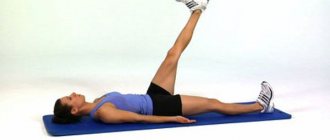Stretching for pregnant women is not only not dangerous, but very useful. As a rule, stretching exercises are the basis of training for pregnant women.
Flexibility and elasticity of muscles are very useful when weight increases during pregnancy. Strong muscles protect joints from the negative effects of increasing stress and help reduce stress on the hamstring muscles and back. In addition, stretching exercises help improve skin elasticity, which, in turn, helps avoid the need to remove stretch marks after pregnancy, which very often overshadows the joyful event of the birth of a baby.
Stretching during pregnancy
Benefits of stretching during pregnancy.
Stretching makes you more flexible, strengthens your muscles, and relieves pain in your back and throughout your body. Stretching also increases your body's range of endurance, which helps prepare you for labor. Plus, stretching is a healthy way to relax and relieve stress.
Exercising during pregnancy works wonders. Sport improves your mood, improves sleep and reduces pain in the lower back and throughout the body. It also prepares you for childbirth by strengthening your muscles and endurance. Research shows that exercise during pregnancy may also reduce the risk of gestational diabetes and preeclampsia. If you have been diagnosed with gestational diabetes, exercise can help you manage the condition and prevent complications.
• Move slowly and gently—your joints and ligaments are more relaxed during pregnancy.
• Stretch each muscle for 10-30 seconds. Your muscles need these seconds to fully relax.
• Do not jump or stretch your abdominal muscles.
• Stop stretching if you feel discomfort or pain.
• Pay attention to your breathing technique - exhale as you stretch and inhale as you return to your starting position.
• While maintaining the stretch, continue to breathe deeply and slowly. Each time you exhale, gently deepen the stretch.
• After the first trimester, avoid stretching while lying on your back. This position can reduce blood flow to the uterus and cause abnormally low blood pressure and dizziness. Use pillows to support your upper body during stretches that require you to lie down.
• Don't forget about warming up! Warming up as a warm-up prepares your muscles and joints for exercise and slowly increases your heart rate. If you skip your warm-up, you can overextend your muscles and ligaments, resulting in severe soreness and post-workout pain. A good way to warm up is to start your workout at a low intensity and slowly increase it over the first five to eight minutes. This prepares the muscles for more vigorous movements.
• Drink water before, during and after your workout. Otherwise, dehydration may lead to a decrease in the amount of blood reaching the placenta. Dehydration can also increase your risk of overheating and even cause contractions. There's no official recommendation for how much water pregnant women should drink while exercising, but many experts recommend a simple technique to assess whether you're drinking enough: Check the color of your urine. Dark yellow urine is a sign of dehydration.
The expectant mother is obliged to take care of herself, take her health seriously and responsibly, lead a healthy lifestyle and get proper rest. However, this does not mean that she needs to limit herself in everything. After all, pregnancy is not a disease.
Restrictions
During pregnancy, swelling in the lower extremities and joint stiffness are often felt. Therefore, stretching will help get rid of many negative symptoms and manifestations during this wonderful period.
The first thing to eliminate is pressure on the stomach and prone positions. Such exercises should be skipped without exception. This is especially true for movements when the hips and knees are pressed towards the stomach.
You should also avoid twisting movements and exercises that involve the abdominal muscles. It is best to keep the spine straight, or allow a slight natural bend. Tilts can be performed gently, without jerking. But the characteristics of a pregnant woman’s body should be taken into account, so it is also better to avoid tilting the body down towards the legs.
Pregnant women should not perform exercises such as bridges and reverse bridges. There are also stretching exercises, during which a woman can feel the excessive tone of the uterus. You should immediately stop exercising and completely relax.
Jumping and swinging are prohibited in any event. Exercise for a pregnant woman should be done very gently, without stress or weight.
If shortness of breath, increased heart rate or dizziness suddenly appears, you need to lie down and relax. There is no point in continuing the activity.
Main rules for pregnant women
- risk of miscarriage
- threat of premature birth
- weak cervix
- bloody issues
- abnormal placenta previa
- nagging pain in the lower abdomen or lower back
Home » Accessories » Can pregnant women go for stretching? Stretching for pregnant women
- You can perform stretching exercises during pregnancy in any order, but always after a short warm-up.
- Exercises must be performed with moderate tension, holding the final pose for 8-10 seconds.
- Three repetitions of one exercise are enough. Each subsequent repetition should be performed with a slightly greater stretch.
- There should be no painful sensations during exercise, except for lumbar pain characteristic of pregnancy, which, on the contrary, is an indication for more frequent exercise.
- Pregnant women can only perform static exercises, that is, exercises with holding a pose, eliminating vibrations, jerking and pain.
- Exercises in the supine position are contraindicated in the 2nd and 3rd trimesters of pregnancy.
- Stretching exercises can be done every day, but only if you feel well.
We stand in the doorway, placing our hands on the doorframe on both sides at chest level. We place our feet a little wider than usual and relax our knees.
Lowering your chin to your chest, bend your back and lean forward. The pelvis moves backward. Inhale, pull your stomach inward, arching your back as much as possible.
We hold our breath for a few seconds and then exhale, keeping our back bent. We finish the exercise by straightening our back and returning to the starting position.
This exercise relieves tension in the muscles of the back, neck and shoulders.
The best option is to sign up and go to a special group for expectant mothers. An experienced trainer will assess your readiness for certain loads and help you choose the safest exercises. One of the best options for pregnant women is yoga. There are endurance exercises, stretching, and pelvic floor muscle training. In addition, in the process of performing asanas you will learn to breathe correctly, which will definitely be useful during childbirth.
In addition to yoga, any not too intense aerobic exercise is allowed. Swimming in the pool will be very useful. Exercises in water are great for expectant mothers. They strengthen muscles while relieving stress from the spine. In addition, swimming is a good way to relieve stress and just have a good rest.
Do not forget that any exercise should not be overly intense. Take breaks, take care of proper rest between workouts. If you feel weak, dizzy or short of breath, you should stop exercising immediately and consult a doctor as soon as possible.
Any exercises involving strong stretching and sudden movements are strictly prohibited during pregnancy. It’s also worth forgetting about horse riding, cycling, ice skating and diving for a while. Bends and twisting are excluded - they can lead to the threat of miscarriage. In the second half of pregnancy, you cannot perform exercises from a supine position - the risk of oxygen deficiency in the mother and fetus is too great.
Whatever activities you ultimately choose, they should be regular. Two or three times a week will be enough to stay in good shape. The main goal of fitness during pregnancy is not to conquer new heights, but to maintain existing results. Don't forget about walks in the fresh air - this is a great way to maintain good health throughout the day.
- It is strictly forbidden to overheat, this will contribute to disturbances in the baby’s blood supply.
- Overdoing stretching exercises can lead to sprains due to the action of relaxin.
- If the doctor caring for a pregnant woman has diagnosed anemia, multiple pregnancies, or a possible threat of miscarriage, then even exercise during pregnancy becomes a controversial issue.
- It is not recommended for women at any stage of pregnancy to visit stuffy gyms without a proper ventilation system.
- Cardio exercises during pregnancy should be excluded from the exercise program, since the heart is already subject to double load.
The main goal will be to avoid physical activity that could cause injury to the expectant mother or lead to a fall. Therefore, it is better to postpone basketball, horse riding and snowboarding sections to a later date, and return to them only after the baby is born.
So, we found out that pregnant women are not at all prohibited from playing sports, even in the early stages of pregnancy. What is possible and what is not is determined only by specialists. If the expectant mother suddenly develops problems with the thyroid gland, blood vessels, heart, spine, or too rapid weight gain, then active exercises should be abandoned for a while.
Permission for any type of physical activity in this case can only be given by the doctor observing the pregnancy and the obstetrician-gynecologist.
In order for exercises to be beneficial for health, body and muscle mass, they should be done regularly, that is, at least twice a week. Only in this case will the body be in the required tone. Infrequent physical activity during pregnancy will cause more stress than benefit for the expectant mother.
Exercises should begin at least two hours after the last meal, and also do not forget about replenishing the oxygen deficiency in the room or gym.
The developed set of exercises should only provide pleasure and energy and also promote the desire to continue practicing. Overwork is strictly prohibited so that the mother and her unborn baby do not feel discomfort, which can negatively affect the course of pregnancy. Only if you follow all the listed rules and recommendations will physical activity bring benefits and significant results that will help during the birth process.
We suggest you read: Can a nursing mother eat seeds?
Friday, June 15, 2017
You can ride on a flat surface, not uphill or downhill, carefully and leisurely.
In general, it should be borne in mind that playing sports during pregnancy should completely eliminate any possibility of falling or injury. So, you can continue to play tennis, figure skating or cross-country skiing, but at the same time significantly reduce the load and exercise maximum caution.
If you can properly distribute the loads, then you can continue running. What will bring considerable benefits is swimming, which helps pregnant women prepare perfectly for future childbirth. Of course, if there are no medical contraindications.
Because all the arguments are quite ambiguous, no matter how hard the parties to the dispute try.
There are no legislative age restrictions for participation in military-tactical and sports-tactical. That is, from a legal point of view, even a five-year-old child can run around with a marker, but now it’s worth considering the question “can children play paintball” from a more rational point of view.
Characteristics of exercise in early pregnancy
In order for exercises to be beneficial for health, body and muscle mass, they should be done regularly, that is, at least twice a week. Only in this case will the body be in the required tone. Infrequent physical activity during pregnancy will cause more stress than benefit for the expectant mother.
Exercises should begin at least two hours after the last meal, and also do not forget about replenishing the oxygen deficiency in the room or gym.
The developed set of exercises should only provide pleasure and energy and also promote the desire to continue practicing. Overwork is strictly prohibited so that the mother and her unborn baby do not feel discomfort, which can negatively affect the course of pregnancy. Only if you follow all the listed rules and recommendations will physical activity bring benefits and significant results that will help during the birth process.
Tip 1: Can a pregnant woman do leg stretching exercises?
Try to drink 1-2 glasses of water every hour until your urine turns pale yellow or almost clear.
Exercise during pregnancy is so beneficial that the American College of Obstetricians and Gynecologists recommends that healthy women with uncomplicated pregnancies aim to get at least 20 to 30 minutes a day of moderate-intensity exercise. Proper exercise gives you the opportunity to pump up your heart, manages weight gain, and prepares your muscles for labor and the postpartum period without causing undue stress on you or your baby.
Consult your doctor before starting any exercise program. When you start exercising, be sure to listen to your body. Don't overdo it - stop if it hurts or feels uncomfortable.
Exercise burns a lot of calories, so be sure to eat well. When you're pregnant, you naturally gain weight as your baby grows. The extra weight you should gain depends on your pre-pregnancy weight. If your body mass index is in the healthy range (18.5 to 24.9), you need to eat an additional 340 calories per day in the second trimester and about 450 calories per day in the third trimester.
Third trimester
In the 3rd trimester, it is more important than ever to follow the training and not stop the constant load. 3rd trimester pregnancy stretches involve doing daily exercises to ensure you are ready for the day you give birth. The tasks are still the same: training the abdomen, uterus, heart. And another one appeared - the ability to breathe correctly. To do this, inhale for 1-2 seconds and exhale for 3-5. When inhaling, inhale through the stomach, then through the chest (the chest rises). As you exhale, first blow air from the stomach, then from the chest. Runs smoothly.
Stretching exercises for pregnant women are performed very smoothly and with controlled breathing. There is no need to do it for quantity or speed. In our case this is not required. Feel your body, feel it, help it.
The importance of exercise in early pregnancy has long been proven. To the question of whether sports are needed during pregnancy, leading experts give a positive answer. The main thing is to understand what activities will not harm the expectant mother and her baby. Pregnancy is not a disease, so even if a woman has not exercised before, this period can be the beginning of an active life.
Hamstring stretch
Placing the palm of the right hand bent at the elbow on the door frame at shoulder level, we try to turn the body to the left side. We repeat the symmetrical exercise.
This exercise helps relieve tension in the back, shoulders, thigh muscles and lateral abdominal muscles.
With our hands on both sides of the doorway, we lunge forward with our left foot. We inhale, and as we exhale, we contract the muscles of the upper back, bringing the shoulder blades together and lifting the chest. Relaxing, we return to the starting position.
This exercise reduces stress on the upper back and neck.
Place your palms on the wall in front of you and lunge with your left knee forward. We move it forward until a sufficient stretch is felt in the right shin. We repeat the exercise with the other leg.
Exercise reduces the risk of leg cramps.
We sit on a chair, stretch our right leg forward and bend our left leg. Using an elastic band or scarf wrapped around your right foot, pull yourself toward your right leg. Repeat for the other leg.
The exercise also relieves stress on your back.
Sitting on the floor with your legs straight, bend your right leg and place its ankle on your left knee. With your left hand, move your right thigh to the left. Intensify the turn by turning your head to the right over your shoulder. We fix the position for a minute. We repeat the exercise on the other side.
Another exercise: butterfly. Sitting on the mat, we bring our feet together and pull them towards us, pressing on our knees with our elbows or palms.
Very useful during pregnancy. Women who successfully practice before and during pregnancy have a very low risk of perineal rupture during labor and prolonged labor.
Lying on your left side, bending your left leg at the knee and resting your right hand on the floor, stretch your right leg up, pull for a few seconds, and then slowly lower it. We repeat the same for the left leg.
The above complex is quite sufficient to prevent problems associated with changes in the body of a pregnant woman. You can supplement it with other exercises. It is only important to sensibly assess your condition and abilities, as well as follow the basic rules of stretching during pregnancy.
Contraindications to stretching during pregnancy are:
- threat of premature birth;
- risk of miscarriage;
- cervical weakness;
- presence of bloody discharge;
- increased blood pressure;
- placenta previa;
- nagging pain in the lower abdomen and lower back.
Every modern woman knows how important it is to keep herself in good shape. An interesting position does not at all become a reason to stop caring about your appearance. Gone are the recommendations to get as much rest as possible during pregnancy. Modern expectant mothers prefer to live life to the fullest and do not want to give up physical activity.
There is a whole range of simple and safe exercises for pregnant women. They do not have a negative effect on the course of pregnancy and do not pose any risk to the development of the fetus. At the same time, the benefits of such activities are obvious. During pregnancy, adequate physical activity improves general condition, increases stamina and creates a charge of good mood.
A positive effect on the course of the postpartum period was also noted. Women who continue to exercise during pregnancy return to their previous weight much faster. They are less likely to have stretch marks, as well as varicose veins and lower back problems. Not to mention the fact that childbirth in trained women is noticeably easier and calmer.
What should an expectant mother know before starting classes?
So, is it possible to continue exercising during pregnancy? The first step is to get an appointment with your gynecologist. You may find contraindications for playing sports. If the doctor gives the go-ahead, feel free to go to the nearest fitness club and choose a suitable program for yourself.
Can pregnant women do fitness?
Yes, you can do fitness during pregnancy, and in some cases it is simply necessary to do it, but first, let’s take a closer look at the condition of a physically unprepared woman.
First of all, a strong rupture may form during labor. And this can not only be very painful, but also dangerous for the woman and baby.
Further, an unprepared body has a harder time enduring the negative symptoms of pregnancy (cramps, pain).
During childbirth, a woman gets tired faster and concentrates more attention on pain and fears. In addition, it is harder for her to listen to her body and act together with the baby.
Fitness and breathing exercises for pregnant women provide excellent preparation for childbirth. The body trains muscles, tissues and the birth canal. Organs begin to work more correctly and more harmoniously. Thanks to special exercises for pregnant women for the back, the risk of many diseases is reduced. In addition, there is excellent prevention of unpredictable situations during childbirth.
The ability to breathe is a very important skill, thanks to which natural pain relief occurs. And the woman concentrates more attention on the right actions and the child. It is also very pleasant that thanks to breathing exercises for pregnant women, the duration of labor is reduced by several hours.
Finally, thanks to a set of exercises for pregnant women, the woman in labor feels more confident. She understands when to listen to the doctor and how to behave in unpredictable situations.
stretching and splits during pregnancy?
She told me that none of her classmates/athlete friends gave birth without problems. It’s not just that they gave birth - most of them had big problems with the course of pregnancy itself. And my neighbor, too, has three pregnancies and all three are very difficult.
off topic, but still... I had a great time throughout my pregnancy! Up to 7 months inclusive, I taught group classes at a fitness club, and did my last workout at the gym the day before giving birth!!
You're just lucky. Many athletes have serious injuries - but I'm talking about normal athletes. Many have injured backs, which is not great for childbirth.
Dimochka's mom
27.10.2010, 23:27
I don’t think I’m lucky. And then if I don’t have serious injuries, then I’m an ABNORMAL athlete???
I'm talking about serious sport. I really don’t know what kind of sport you have - my friends are gymnasts in track and rhythmic gymnastics - both with severe back injuries and one swimmer also with an injured back. Two had cesarean sections - the last one had a difficult birth.
If everything is fine with you, I consider you lucky. Many people don't.
Dimochka's mom
27.10.2010, 23:49
My sport is diving. I’ve been doing it since I was 6 years old. I jumped from towers
I have girlfriends much longer. 15 years somewhere... I won’t say - but I have someone to look at and listen to.
In my group at the Institute named after. Lesgaft, two girls’ children died in childbirth, one was premature (6 months), this was during her studies, department of gymnastics. I had a quick birth, there was no pushing, the baby was squeezed out.
And the doctor did everything for me during childbirth in her own way, so she didn’t give a damn about my past medical history. Labor was induced by examination, the bladder was opened, the cervix was opened completely manually. By the way, there was no pushing either (they didn’t wait, they squeezed it out. The doctor had to go home soon)
Maybe if things had gone their way, things would have been different.
We suggest you read: What you can do for pregnant women for fever
besides, it matters what kind of sport
Katerinka and Karinka
28.10.2010, 02:45
depends on the sport! By the way, it is very difficult for gymnasts to give birth because if they have been training seriously and for a long time, then most have problems with cartilage tissue, many make a crunch even after just “sitting and walking” (ALL!! professional gymnasts are required to undergo examination 2 times a year - I do not mean those who are further did not go to regional competitions)
and in figure skaters, the pelvic bones are “twisted”; during B, with an increased load on the lumbosacral region, “pinching” of the nerves often occurs, unfortunately, I don’t know the purely medical names
I had a quick and easy birth, although I had the problems listed above. The doctor said 1) it’s good that the abs are no longer the same as before (I haven’t worked out for a long time) 2) she speaks poorly, she probably worked out: 065:, athletes have a harder time giving birth
I am a master of sports in swimming.
the midwife warned before giving birth that it is difficult for GYMNASTS to give birth)) but for everyone else, it’s normal, because... I have experience in WORK, PLOWING, STRESS):065:I had a rapid birth, thanks to sports and everything went very well. Fine.
Manderley
28.10.2010, 11:39
complete nonsense!! You are a happy exception to the rule!











